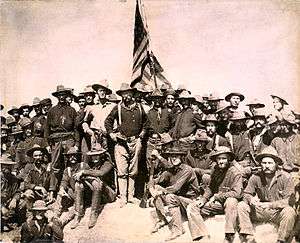Leonard Wood
| Major General Leonard Wood | |
|---|---|
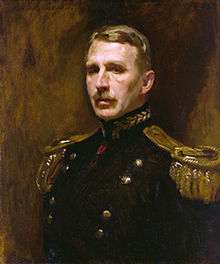 A 1903 painting of Wood, by John Singer Sargent | |
| Governor-General of the Philippines | |
|
In office October 14, 1921 – August 7, 1927 | |
| Preceded by | Charles Yeater |
| Succeeded by | Eugene Allen Gilmore |
| Governor of Moro Province | |
|
In office July 25, 1903 – April 16, 1906 | |
| Preceded by | position established |
| Succeeded by | Tasker Howard Bliss |
| Governor-General of Cuba | |
|
In office December 23, 1899 – May 20, 1902 | |
| Preceded by | John Ruller Brooke |
| Succeeded by |
Position abolished (Tomás Estrada Palma, as President of Cuba) |
| Personal details | |
| Born |
October 9, 1860 Winchester, New Hampshire, U.S. |
| Died |
August 7, 1927 (aged 66) Boston, Massachusetts, U.S. |
| Political party | Republican |
| Spouse(s) |
Louise A. Condit Smith (1869-1943) (m. 1890; his death 1927) |
| Education | Harvard Medical School (M.D., 1884) |
| Profession | Soldier, physician |
| Religion | Episcopal |
| Awards |
Medal of Honor Army Distinguished Service Medal |
| Military service | |
| Allegiance |
|
| Service/branch |
|
| Years of service | 1886–1921 |
| Rank |
|
| Commands |
1st U.S. Volunteer Cavalry Department of the East Chief of Staff of the U.S. Army |
| Battles/wars |
Apache Wars Spanish–American War Philippine–American War |
Leonard Wood (October 9, 1860 – August 7, 1927) was a United States Army officer. He served as the Chief of Staff of the United States Army, Military Governor of Cuba, and Governor General of the Philippines. He began his military career as an army doctor on the frontier, where he received the Medal of Honor. He was bypassed for a major command in World War I, but then became a prominent Republican Party leader and a candidate for the 1920 presidential nomination. He served as civilian Governor General in the Philippines in the 1920s, where he quarreled with Filipinos who wanted home rule.
Biographer Jack Lane sums up his importance:
- Wood played a significant role in shaping many of the United States's major developments in the early twentieth century: progressivism, expansionism and colonialism, military reform, preparedness and American intervention in World War I, and the election of 1920. He was particularly representative of an era that valued moral and physical strength. Although admired by his generation for his honesty, forthrightness, and his intense and vigorous approach to life, he fell short of greatness.[1]
Early life and education
Born in Winchester, New Hampshire to Charles Jewett Wood (1829–1880) and Caroline E. (Hagar) Wood (1836–1910), Wood attended Pierce Academy in Middleborough, Massachusetts and Harvard Medical School, earning an M.D. degree in 1884 as an intern at Boston City Hospital. Leonard Wood was of English descent, and was descended from four Mayflower passengers including William White, Francis Cooke, Stephen Hopkins and Richard Warren. He was married to Louise Adriana Condit Smith (1869–1943), of Washington, on November 18, 1890.[2][3]
Career
Wood took a position as an Army contract surgeon in January 1886, and was stationed with the 4th Cavalry at Fort Huachuca, Arizona. Wood participated in the last campaign against Geronimo in 1886, and was awarded the Medal of Honor for carrying dispatches 100 miles through hostile territory and for commanding a detachment of the 8th Infantry (whose officers had been lost) in hand-to-hand combat against the Apache. He received the rank of captain in 1891.[4]
While stationed at Fort McPherson in Atlanta, in 1893, Wood enrolled in graduate school at Georgia Tech, then known as the Georgia School of Technology, and organized the school's 1893 football team. Wood was the team's coach and played left guard, leading Georgia Tech to a 2–1–1 record, including a 28–6 victory over the University of Georgia.[5] He was awarded an LL.D. by Harvard in 1899.
Spanish–American War
Wood was personal physician to Presidents Grover Cleveland and William McKinley through 1898. It was during this period he developed a friendship with Theodore Roosevelt, then Assistant Secretary of the Navy. At the outbreak of the Spanish–American War, Wood, with Roosevelt, organized the 1st Volunteer Cavalry regiment, popularly known as the Rough Riders. Wood commanded the regiment in a successful engagement known as the Battle of Las Guasimas. When the brigade commander, Samuel B. M. Young, became ill, Wood received a field promotion to brigadier general of volunteers and assumed command of the 2nd Brigade, Cavalry Division, Fifth Army Corps (which included the Rough Riders) and led the brigade to a famous victory at Kettle Hill and San Juan Heights.[6]
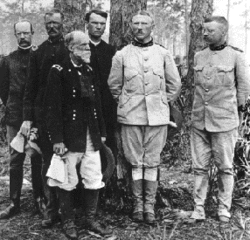
After San Juan, Wood led the 2nd Cavalry Brigade for the rest of the war; he stayed in Cuba after the war and was appointed the Military Governor of Santiago in 1898, and of Cuba from 1899–1902. In that capacity, he relied on his medical experience to institute improvements to the medical and sanitary conditions in Cuba. He introduced numerous reforms similar to those of the Progressive Movement in the U.S.[7] He was promoted to brigadier general of regulars shortly before moving to his next assignment.
Philippine–American War
In 1902, he proceeded to the Philippines, where he commanded the Philippines Division and later became commander of the Department of the East. He was promoted to major general in 1903 despite significant opposition,[8] and served as governor of Moro province, a stronghold of Muslim rebellion, from 1903 to 1906. He received criticism for his handling of the battle at First Battle of Bud Dajo where hundreds of women and children were killed.
Army Chief of Staff
Wood had known Theodore Roosevelt well before the Spanish–American War. Wood was named Army Chief of Staff in 1910 by President Taft, whom he had met while both were in the Philippines; he remains the only medical officer to have ever held that position. As Chief of Staff, Wood implemented several programs, among which were the forerunner of the Reserve Officer Training Corps (ROTC) program, and the Preparedness Movement, a campaign for universal military training and wartime conscription. The Preparedness Movement plan was scrapped in favor of the Selective Service System, shortly before World War I. He developed the Mobile Army, thus laying the groundwork for American success in World War I.
World War I
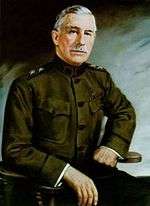
In 1914, Wood was replaced as Chief of Staff by William Wotherspoon. Wood was a strong advocate of the Preparedness Movement, led by Republicans, which alienated him from President Wilson. In 1915, he published The Military Obligation of Citizenship.
With the U.S. entry into World War I in April 1917, Wood was recommended by Republicans, in particular Henry Cabot Lodge, to be the U.S. field commander. However Wood was too closely identified with Republicans and War Secretary Newton Baker instead appointed John J. Pershing, a non-partisan choice. During the war, Wood was, instead, given the minor non-combat roles in charge of the training of the 10th and 89th Divisions, both at Camp Funston.
Republican politics
Wood was an unsuccessful candidate for the Republican presidential nomination in the election of 1920. He was urged into running by the family and supporters of his old friend Theodore Roosevelt, who himself had been considering another campaign before his illness and death in 1919. He won the New Hampshire primary that year but lost at the convention.
Among the reasons that he did not become the candidate were several strong rivals for the nomination, his political inexperience, and the strong support he gave to the Red Scare, Attorney General A. Mitchell Palmer's campaign against Bolsheviks and anarchists. After the major candidates deadlocked, the nomination went to U.S. Senator Warren G. Harding of Ohio.
Governor General of the Philippines
He retired from the U.S. Army in 1921, after which he was appointed as Governor General of the Philippines later that year.[9]
His tenure as was characterized with marked tension between him and key Filipino officials. In his first year, Wood vetoed 16 measures passed by the Philippine Legislature, an act denounced by critics as a "misuse of the veto power," citing that his predecessor, Francis Burton Harrison, only vetoed 5 measures.[10]
The tension became more heightened by 1923, precipitated by the issue regarding Wood's interference in the case of Ray Conley, a Manila Police detective who was accused of immorality and misconduct in office. Interior Secretary Jose P. Laurel sought Conley's removal from service due to probable cause but Wood ordered Laurel to reinstate Conley to the police force. In protest, Laurel tendered his resignation.[11] The Filipino members of the Wood cabinet, including the Council of State, tendered their resignations as well in support of Laurel and in protest of Wood's handling of government affairs in the country. These events would become known as the "Cabinet Crisis of 1923," effectively straining relations between the U.S. colonial government under Wood and the Filipino leaders that would last until his death in 1927.[12]
Later life and death
Wood died in Boston after undergoing surgery for a recurrent brain tumor. He had initially been diagnosed in 1910 with a benign meningioma brought on by exposure to experimental weapons refuse. This was resected by Harvey Cushing at that time, and Wood made a full recovery until the tumor later recurred. The successful removal of Wood's brain tumor represented an important milestone, indicating to the public the advances that had been made in the nascent field of neurosurgery, and extending Wood's life by almost two decades.[13]
He is buried in Arlington National Cemetery.[14][15] His brain is held at the Yale University School of Medicine as part of an historic collection of Harvey Cushing's patients' preserved brains.
Legacy
Camp Leonard Wood in Missouri, now Fort Leonard Wood, home of the United States Army Combat Engineer School, Chemical School, and Military Police School, is named in his honor. Ft. Leonard Wood is also a major TRADOC post for Basic Combat Training (BCT), home of the 10th Infantry Regiment (Basic Training).
One of the U.S. Navy's Harris-class attack transports, the USS Leonard Wood (APA-12), bears Wood's name. Numerous streets are named after Wood, including roads in Baguio City and Zamboanga City, Philippines A Public Elementary School in Barangay Jagobiao, Mandaue City, Philippines (inside Eversley Childs Sanitarium compound) was also named after him.
For a brief period of time, Guadalupe County, New Mexico, was named after Wood. After a few years it was changed back to Guadalupe.
In popular culture
- Wood is portrayed favorably in the 1997 miniseries Rough Riders by actor and retired United States Marine Dale Dye, but portrayed in a less favorable light by Mark Twain and others for his part in the First Battle of Bud Dajo in 1906.
Awards and decorations
- Medal of Honor
- Distinguished Service Medal
- Indian Campaign Medal
- Spanish Campaign Medal
- Army of Cuban Occupation Medal
- Philippine Campaign Medal
- World War I Victory Medal
Medal of Honor citation
Voluntarily carried dispatches through a region inhabited by hostile Indians, making a journey of 70 miles in one night and walking 30 miles the next day. Also for several weeks, while in close pursuit of Geronimo's band and constantly expecting an encounter, commanded a detachment of Infantry, which was then without an officer, and to the command of which he was assigned upon his own request.
Dates of rank
| Rank | Date | Component |
|---|---|---|
| 5 January 1886 | Regular Army | |
| 5 January 1891 | Regular Army | |
| 8 May 1898 | Volunteers | |
| 8 July 1898 | Volunteers | |
| 7 December 1898 | Volunteers | |
| 13 April 1899 | Volunteers | |
| 5 December 1899 | Volunteers | |
| 4 February 1901 | Regular Army | |
| 8 August 1903 | Regular Army |
Head coaching record
| Year | Team | Overall | Conference | Standing | Bowl/playoffs | ||||
|---|---|---|---|---|---|---|---|---|---|
| Georgia Tech Yellow Jackets (Independent) (1893) | |||||||||
| 1893 | Georgia Tech | 2–1–1 | |||||||
| Georgia Tech: | 2–1–1 | ||||||||
| Total: | 2–1–1 | ||||||||
See also
- Adventurers' Club of New York
- List of Medal of Honor recipients
- List of Medal of Honor recipients for the Indian Wars
- List of people on the cover of Time magazine (1920s)—19 April 1926
References
- ↑ Jack C. Lane. "Wood, Leonard" American National Biography Online (2000).
- ↑ Jack McCallum, Leonard Wood pp 7-10
- ↑ Eric Fisher Wood, Leonard Wood (1920), page 22
- ↑ McCallum, Leonard Wood pp 10-46
- ↑ Byrd, Joseph (Spring 1992). "From Civil War Battlefields to the Moon: Leonard Wood". Tech Topics. Georgia Tech Alumni Association. Archived from the original on 2007-02-09. Retrieved 2007-03-12.
- ↑ McCallum, Leonard Wood pp 47-111
- ↑ Jack C. Lane. "Wood, Leonard"; American National Biography Online (2000)
- ↑ EVIDENCE IN WOOD CASE: Major Runcie Tells of Magazine Article Attacking General Brooke: WRITTEN AT WOOD'S REQUEST: Article Exploited His Success at Santiago and Spoke Unfavorably of General Brooke's Administration of Havana, published November 28, 1903, in the Daily Star (via Google News)
- ↑ Jones, O. Garfield (September 28, 1921). "What Wood and Forbes Have Done In The Philippines". The Outlook. 129: 133–135. Retrieved 2009-07-30. Also see Robb, Walter (November 30, 1921). "Wood Facing His Task". The Outlook. 129: 512–513. Retrieved 2009-07-30.
- ↑ Onorato, Michael (2005). "Leonard Wood: His First Year as Governor-General" (PDF). Asian Studies. 41 (2): 57.
- ↑ Cruz, Isagani (May 12, 2000). "The Cabinet Crisis of 1923". Philippine Daily Inquirer.
- ↑ Halili, Maria Christine (2010). Philippine History.
- ↑ Lee, Joung H. (2009). Meningiomas: Diagnosis, Treatment, and Outcome. Springer. p. 8. ISBN 978-1-84882-910-7.
- ↑ Arlingtoncemetery.net
- ↑ Leonard Wood at Find a Grave
Additional sources
- Bacevich, A. J. Diplomat in Khaki: Major General Frank Ross McCoy and American Foreign Policy, 1898-1949 (1989), biography of Wood's principal aide.
- Eisenhower, John S.D. Teddy Roosevelt and Leonard Wood: Partners in Command (University of Missouri Press, 2014).
- Hagedorn, Hermann, Leonard Wood, a Biography (2 vols., 1931), detailed authorized biography
- Lane, Jack C. Armed Progressive: General Leonard Wood (1978), a major scholarly biography
- Lane, Jack C. "Wood, Leonard"; American National Biography Online 2000. Access Mar 11 2016
- McCallum, Jack (2005). Leonard Wood: Rough Rider, Surgeon, Architect of American Imperialism.
- Pruitt II, James Herman. "Leonard Wood and the American Empire" (PhD dissertation Texas A&M University, 2011); online; bibliography on pp 296-315.
- US soldiers pose with the bodies of Moro insurgents, Philippines, 1906
Primary sources
- Wood, Leonard. Chasing Geronimo: The Journal of Leonard Wood, May – September, 1886. Edited, with Introduction and Epilogue, by Jack C. Lane. Albuquerque: University of New Mexico Press, 1970.
External links
 Works written by or about Leonard Wood at Wikisource
Works written by or about Leonard Wood at Wikisource Media related to Leonard Wood at Wikimedia Commons
Media related to Leonard Wood at Wikimedia Commons
| Military offices | ||
|---|---|---|
| Preceded by John R. Brooke |
Military Governor of Cuba 1899–1902 |
Succeeded by none |
| Preceded by J. Franklin Bell |
Chief of Staff of the United States Army 1910–1914 |
Succeeded by William W. Wotherspoon |
| Political offices | ||
| Preceded by Charles Yeater |
Governor-General of the Philippines 1921–1927 |
Succeeded by Eugene Allen Gilmore |

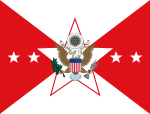
.svg.png)
